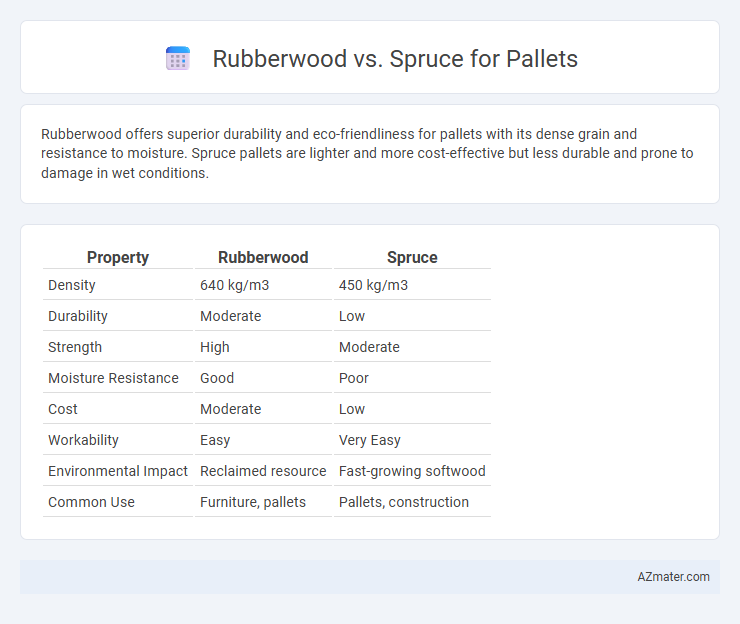Rubberwood offers superior durability and eco-friendliness for pallets with its dense grain and resistance to moisture. Spruce pallets are lighter and more cost-effective but less durable and prone to damage in wet conditions.
Table of Comparison
| Property | Rubberwood | Spruce |
|---|---|---|
| Density | 640 kg/m3 | 450 kg/m3 |
| Durability | Moderate | Low |
| Strength | High | Moderate |
| Moisture Resistance | Good | Poor |
| Cost | Moderate | Low |
| Workability | Easy | Very Easy |
| Environmental Impact | Reclaimed resource | Fast-growing softwood |
| Common Use | Furniture, pallets | Pallets, construction |
Introduction: Rubberwood vs Spruce for Pallet Manufacturing
Rubberwood offers durability and resistance to wear, making it an ideal choice for pallet manufacturing in industries requiring sturdy load-bearing capacity. Spruce, known for its lightweight properties and ease of machining, provides cost-efficiency and faster production times in pallet manufacturing processes. Selecting between rubberwood and spruce depends on balancing factors such as load requirements, environmental conditions, and budget constraints for optimal pallet performance.
Overview of Rubberwood and Spruce Materials
Rubberwood, derived from the Para rubber tree (Hevea brasiliensis), is a hardwood known for its durability, resistance to warping, and sustainability due to being a byproduct of rubber production. Spruce, a softwood from the genus Picea, is lightweight and moderately strong but less resistant to moisture and pests compared to hardwoods. In pallet manufacturing, rubberwood offers enhanced longevity and structural integrity, while spruce provides cost-effective, lightweight solutions suitable for lighter loads.
Physical Properties Comparison
Rubberwood exhibits a density of approximately 640 kg/m3, offering moderate hardness and excellent resistance to impact, making it durable for pallet construction. In contrast, Spruce has a lower density around 450 kg/m3, resulting in lighter weight but less strength and reduced resistance to wear. The dimensional stability of Rubberwood surpasses Spruce, with less susceptibility to warping or cracking under varying humidity conditions, which is critical for pallet longevity.
Durability and Strength Analysis
Rubberwood offers superior durability and strength compared to spruce, making it a preferred choice for heavy-duty pallets designed to withstand repeated handling and high load capacities. Spruce, while lighter and more economical, tends to have lower density and strength, which can limit its performance under stress and reduce pallet lifespan. The higher Janka hardness rating of rubberwood signifies better resistance to dents and impact, crucial for industrial pallet applications.
Environmental Impact and Sustainability
Rubberwood pallets are highly sustainable due to their use of plantation-grown timber from rubber trees at the end of their latex-producing life, reducing waste and deforestation. Spruce pallets, sourced from fast-growing softwood forests, offer rapid renewability, but their harvesting can contribute to habitat disruption if not managed sustainably. Rubberwood's lower carbon footprint and utilization of byproducts make it an environmentally preferred choice over spruce in pallet manufacturing.
Cost Efficiency and Availability
Rubberwood offers superior cost efficiency compared to spruce for pallet manufacturing due to its widespread availability as a byproduct of the rubber industry, ensuring lower raw material costs and stable supply chains. Spruce, while lighter and easier to handle, tends to be more expensive and less abundant, leading to fluctuations in price and potential sourcing delays. Choosing rubberwood pallets maximizes budget optimization and ensures consistent availability for large-scale industrial use.
Moisture Resistance and Pest Control
Rubberwood offers superior moisture resistance compared to spruce, making it less prone to warping and swelling in humid conditions, which is crucial for pallets exposed to varying weather. Its natural oils provide inherent pest resistance, reducing the need for chemical treatments commonly required for spruce pallets. Spruce, being softer and more porous, absorbs moisture readily and is more susceptible to insect infestation, leading to shorter pallet lifespan in demanding environments.
Weight and Load-bearing Capacity
Rubberwood pallets typically weigh more than spruce pallets, offering enhanced durability and a higher load-bearing capacity suitable for heavy-duty shipping. Spruce pallets are lighter, making them easier to handle but less capable of supporting substantial weights over prolonged periods. Choosing rubberwood enhances pallet stability and longevity in demanding logistics environments where weight capacity is crucial.
Common Applications and Industry Preferences
Rubberwood is favored in pallet manufacturing for its durability and resistance to insect damage, making it ideal for heavy-load shipping and export pallets in industries like furniture and electronics. Spruce, a softer wood, is commonly used for lightweight pallets and crates in the food and beverage sector due to its cost-effectiveness and ease of handling. Industry preference leans towards rubberwood for high-strength, reusable pallets, while spruce is selected for disposable or single-use pallets where budget constraints are paramount.
Conclusion: Choosing the Best Wood for Pallets
Rubberwood offers superior durability and resistance to moisture, making it an excellent choice for pallets requiring long-term use and heavy loads. Spruce, while more lightweight and cost-effective, may lack the robustness needed for heavy-duty applications but is suitable for pallets intended for lighter, short-term shipping. Selecting the best wood depends on balancing budget constraints with performance needs, where Rubberwood excels in strength and sustainability, and Spruce provides affordability and ease of handling.

Infographic: Rubberwood vs Spruce for Pallet
 azmater.com
azmater.com